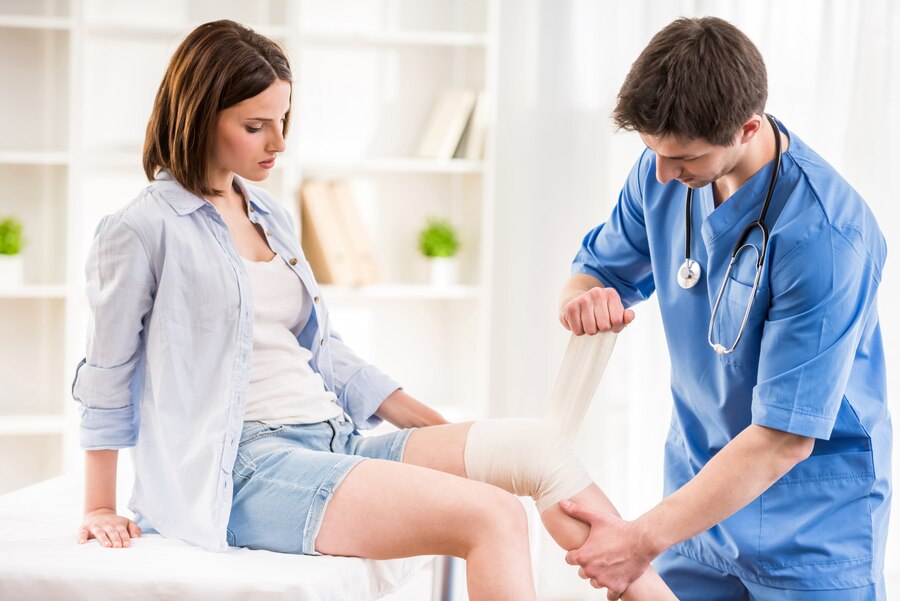Urgent Care for Sprains – Walk-In Treatment for Quick Healing
A sprain is one of the most common musculoskeletal injuries, affecting the ligaments that connect bones and support joints. Whether it’s a twisted ankle, a sprained wrist, or a knee injury, timely treatment is crucial for a fast and complete recovery.
Urgent care centers provide quick and efficient treatment for sprains, offering walk-in evaluations, on-site X-rays, pain relief, and recovery guidance. These clinics serve as a convenient alternative to emergency rooms, helping patients get back to their normal activities without long wait times or expensive hospital bills.
In this article, we will explore the causes, symptoms, treatment options, and benefits of visiting urgent care for sprains.
Understanding Sprains – Causes, Symptoms, and Severity Levels
A sprain occurs when the ligaments that connect bones in a joint are stretched or torn, leading to pain, swelling, and difficulty moving the affected area. Sprains are common in ankles, wrists, knees, and thumbs, and they often result from falls, sudden twists, or sports injuries.
Common Causes of Sprains
- Sports injuries – Running, jumping, or sudden changes in direction.
- Slips and falls – Uneven surfaces, icy sidewalks, or wet floors.
- Overextension – Stretching a joint beyond its normal range of motion.
- Lifting heavy objects incorrectly – Straining the ligaments in the back or wrist.
Symptoms of a Sprain
The severity of a sprain can vary, but common symptoms include:
- Pain and tenderness around the affected joint.
- Swelling and bruising at the injury site.
- Limited range of motion and difficulty bearing weight.
- A popping sensation at the time of injury (in severe cases).
Grading the Severity of a Sprain
Sprains are classified into three grades based on their severity:
- Grade 1 (Mild): Ligaments are overstretched, causing minor swelling and discomfort.
- Grade 2 (Moderate): Partial tearing of the ligament, leading to significant swelling and difficulty moving the joint.
- Grade 3 (Severe): A complete ligament tear, resulting in extreme pain, instability, and the need for medical intervention.
When to Visit Urgent Care for a Sprain
Not all sprains require emergency care, but visiting urgent care is recommended when:
Signs You Should Seek Urgent Care for a Sprain
- Severe pain or swelling that does not improve with home treatment.
- Inability to bear weight on the injured joint.
- Visible deformity or instability in the affected area.
- Excessive bruising or signs of infection, such as redness or warmth.
- A popping sound or sensation at the time of injury.
Urgent Care vs. Emergency Room – Where Should You Go?
| Urgent Care | Emergency Room (ER) |
| Mild to moderate sprains | Suspected fractures or dislocations |
| No severe swelling or deformity | Severe pain with visible joint misalignment |
| No nerve damage (tingling or numbness) | Open wounds or severe bleeding |
| Quick evaluation and X-ray services | Life-threatening or complex injuries |
If the injury appears severe, involves broken bones, or causes intense pain, go to the ER immediately. Otherwise, urgent care is the best choice for fast and cost-effective treatment.
How Urgent Care Treats Sprains – The Diagnosis and Recovery Process
At urgent care, healthcare professionals quickly assess the severity of the sprain, perform necessary imaging, and develop a personalized treatment plan.
Diagnosis and Evaluation
When you visit an urgent care center for a sprain, the medical team will:
- Examine the injured area – Checking for swelling, bruising, and tenderness.
- Assess your range of motion – Determining joint stability and pain levels.
- Order an X-ray (if needed) – Ruling out fractures or severe ligament damage.
- Discuss your symptoms and medical history – Understanding how the injury occurred and any past joint issues.
Treatment Options for Sprains
Once diagnosed, urgent care will recommend a personalized treatment plan, which may include:
- R.I.C.E. Therapy (Rest, Ice, Compression, Elevation) – Helps reduce swelling and pain.
- Pain Relief Medications – NSAIDs like ibuprofen to manage discomfort.
- Bracing or Splinting – Provides joint support to prevent further injury.
- Physical Therapy Recommendations – Exercises to restore strength and mobility.
- Crutches or Walking Aids (if necessary) – Reducing weight on the affected joint.
For moderate to severe sprains, follow-up visits may be required to monitor healing progress and adjust the treatment plan as needed.
FAQs About Urgent Care for Sprains
1. Can urgent care do X-rays for sprains?
Yes, most urgent care clinics offer on-site X-ray services to check for fractures or severe ligament damage.
2. Will I need crutches for a sprain?
For moderate to severe sprains, crutches may be recommended to prevent further strain on the injured joint.
3. What should I do before visiting urgent care for a sprain?
Apply ice, elevate the injured limb, and avoid putting weight on the joint until you receive medical care.
4. Can a sprain turn into a more serious injury if untreated?
Yes. Without proper treatment, a sprain can lead to chronic pain, joint instability, and an increased risk of re-injury.
5. How much does urgent care treatment for a sprain cost?
The cost varies but is significantly lower than an ER visit. Most insurance plans cover urgent care services, including X-rays and treatment.
Conclusion: Get Fast, Reliable Sprain Treatment at Urgent Care
A sprain may seem like a minor injury, but without proper treatment, it can lead to long-term joint issues. Visiting urgent care for a sprain ensures quick diagnosis, pain management, and a structured recovery plan—all without the long wait times of an ER.
If you experience severe pain, swelling, or difficulty moving the joint, don’t ignore it. Visit our urgent care clinic today for fast and effective treatment (214) 949-8918 or visit us https://specialtycareclinics.com/
